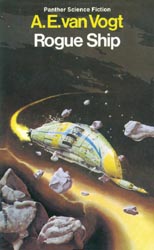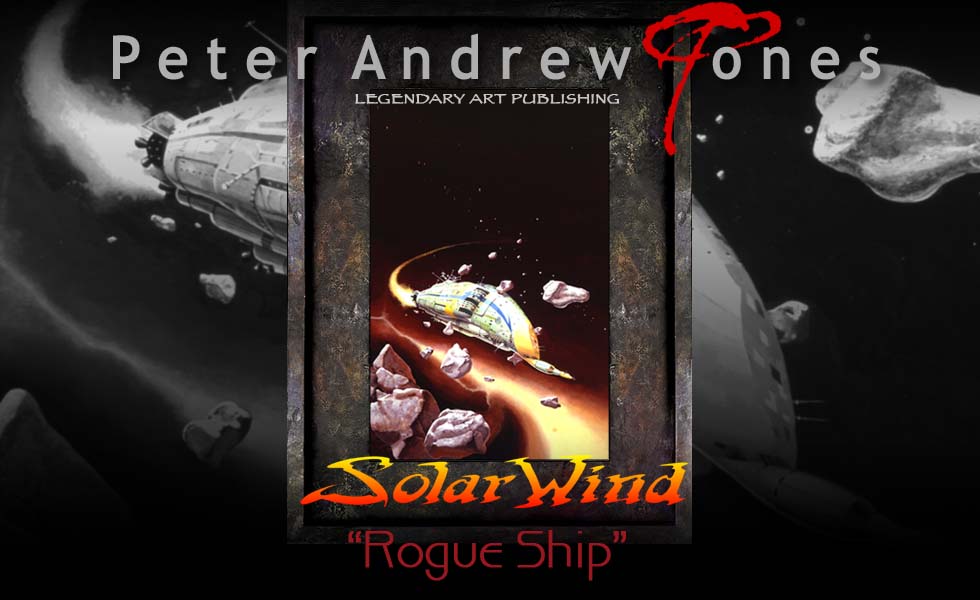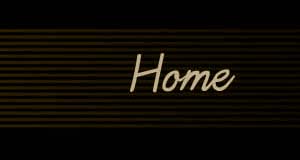
|
 "Rogue Ship" "Rogue Ship"
 (From the book "Solar Wind") (From the book "Solar Wind")
 By :
Deborah Susan Jones :
Editor By :
Deborah Susan Jones :
Editor
 Created
for the Panther Books paperback edition of the story in
the 70's by the
Artist, the novel was created in 1967 as an adaption
from three short
stories, which were; Created
for the Panther Books paperback edition of the story in
the 70's by the
Artist, the novel was created in 1967 as an adaption
from three short
stories, which were;
- Centaurus II. Originally published in Astounding
Science Fiction Magazine in 1947.
- Rogue Ship. Originally published in Super Science
Stories in 1950.
- The Expendables. Originally published in Worlds of
Science Fiction in 1963.
  In
the painting the Artist has created a vast spaceship of
many colours
and fully armed. He has visualised the mighty space
cruiser in Van
Vogt's novel as it coasts through the dreadful emptiness
of Space,
which is uncharacteristically rendered in a deep warm
brown rather than
the totally forbidding empty blackness that was all too
often typical
of the time, in an early experiment of what came to be a
signature of
many of his SF works, that of unconventionally coloured
space, although
while this was considered a strikingly unusual approach
by most art
directors at the time, in fact it deliberately
referenced the works of
earlier SF Artists in the pulp magazines era. In
the painting the Artist has created a vast spaceship of
many colours
and fully armed. He has visualised the mighty space
cruiser in Van
Vogt's novel as it coasts through the dreadful emptiness
of Space,
which is uncharacteristically rendered in a deep warm
brown rather than
the totally forbidding empty blackness that was all too
often typical
of the time, in an early experiment of what came to be a
signature of
many of his SF works, that of unconventionally coloured
space, although
while this was considered a strikingly unusual approach
by most art
directors at the time, in fact it deliberately
referenced the works of
earlier SF Artists in the pulp magazines era.
 Space
is neutral and gives no feelings of safety or comfort in
most Artists
works, but here the rocks trigger feelings of lack
of control as
they convey danger and a sense of pending calamity as
the ship attempts
to navigate a path through the hurling asteroid shower
onward to its
destination, Centaurus, and its mission to save
humanity. Space
is neutral and gives no feelings of safety or comfort in
most Artists
works, but here the rocks trigger feelings of lack
of control as
they convey danger and a sense of pending calamity as
the ship attempts
to navigate a path through the hurling asteroid shower
onward to its
destination, Centaurus, and its mission to save
humanity.
 The
size of the craft and its predicament suggest that the
humans traveling
in it are vulnerable in their isolation to feelings of
restlessness,
panic and mutiny and in the image at least, impending
impact with space
debris. Wanting to return to a place they know, Earth, and
not continue
on to face the uncertainty of the unknown, they seem to
have no ability
to do so leaving the Captain to face the future with what
is vital, his
knowledge that Earth was possibly, by then, obliterated,
with the
implication that Centaurus was his one hope . . . .
. . . . The
size of the craft and its predicament suggest that the
humans traveling
in it are vulnerable in their isolation to feelings of
restlessness,
panic and mutiny and in the image at least, impending
impact with space
debris. Wanting to return to a place they know, Earth, and
not continue
on to face the uncertainty of the unknown, they seem to
have no ability
to do so leaving the Captain to face the future with what
is vital, his
knowledge that Earth was possibly, by then, obliterated,
with the
implication that Centaurus was his one hope . . . .
. . . .
 The
design the Artist came up with was intended to present the
viewer with
a scene, "a feeling", that showed a spacecraft hurtling at
terrific
speed and creating a sense that, whatever the wishes,
desires, fears
and anxieties or mutinous attempts of its occupants, they
would be as
naught compared with the inescapable on-rush to a
predetermined
destination that the sheer speed of the craft itself
(indeed, a "Rogue
Ship" was the briefing discussion had with the Art
Director (Steve
Abis) before commencement of the painting) would override
any
intentions or wishes of the passengers inside. The
design the Artist came up with was intended to present the
viewer with
a scene, "a feeling", that showed a spacecraft hurtling at
terrific
speed and creating a sense that, whatever the wishes,
desires, fears
and anxieties or mutinous attempts of its occupants, they
would be as
naught compared with the inescapable on-rush to a
predetermined
destination that the sheer speed of the craft itself
(indeed, a "Rogue
Ship" was the briefing discussion had with the Art
Director (Steve
Abis) before commencement of the painting) would override
any
intentions or wishes of the passengers inside.
 This
approach, non-narrative and more emotive in nature than
was typical of
Science Fiction Artists of the time, became a central
theme in how the
Artist approached developing what came to be known as "The
PAJ style"
which is as much about the emotions of the participants in
a portrayed
event as it is about mere artistic technique. This
approach, non-narrative and more emotive in nature than
was typical of
Science Fiction Artists of the time, became a central
theme in how the
Artist approached developing what came to be known as "The
PAJ style"
which is as much about the emotions of the participants in
a portrayed
event as it is about mere artistic technique.
 Deborah Susan Jones Deborah Susan Jones
|
 |







